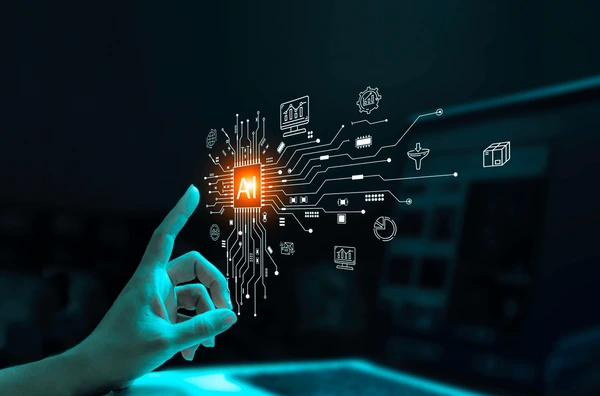
AI in L&D: Transforming Corporate Learning for the Future
The rapid advancements in artificial intelligence (AI) are transforming various aspects of business, and Learning and Development (L&D) is no exception. AI’s potential to revolutionize how organizations train and develop their workforce is undeniable, ushering in new efficiencies, personalized learning experiences, and significant cost savings.
As AI moves from experimental applications to mainstream adoption in L&D, understanding its implications is crucial for organizations looking to stay ahead in an increasingly competitive environment.
Emerging Trends in AI for Learning and Development

AI is not just a passing trend in the world of Learning and Development; it is a fundamental shift in how training programs are designed, delivered, and assessed. As AI continues to evolve, it is expected to impact L&D in several profound ways. Below, we explore the key trends that will shape the future of L&D, offering insights into how AI can be harnessed to enhance learning outcomes and optimize training budgets.
#1. Accelerating Content Creation and Delivery
One of the most significant impacts of AI on L&D is its ability to streamline and accelerate content creation. Traditional methods of developing training materials often involve time-consuming processes, substantial resources, and the coordination of a large team of instructional designers, subject matter experts, and trainers. AI is changing this paradigm dramatically.
According to a study by the Association for Talent Development (ATD), organizations spend an average of 38 hours developing just one hour of training content using traditional methods. AI-powered tools have the potential to reduce this time by up to 70%, allowing L&D teams to create high-quality content at an unprecedented pace.
Moreover, AI enables rapid content updates, ensuring that training materials remain current and relevant. In industries where information quickly becomes obsolete, this agility is crucial. For instance, in the tech sector, where new programming languages and frameworks emerge regularly, AI can help L&D teams keep pace with these changes, ensuring that employees’ skills remain cutting-edge.
Recommended reading: Guide to Building a Learning Culture in Your Organisation
#2. Personalized Learning Experiences at Scale
The one-size-fits-all approach to training is becoming obsolete. AI’s ability to analyze vast amounts of data and identify individual learning patterns is ushering in an era of hyper-personalized learning experiences.
A report by LinkedIn Learning reveals that 94% of employees would stay at a company longer if it invested in their learning and development. AI can take this investment to the next level by tailoring learning pathways to each employee’s role, skill level, learning style, and career aspirations.
For example, an AI-driven L&D platform might recognize that a marketing specialist learns best through interactive case studies, while a data analyst prefers text-based explanations followed by practical exercises. The system would then curate and deliver content in these preferred formats, optimizing the learning experience for each individual.
#3. Enhancing Learner Engagement

Engagement is a critical factor in the success of any L&D initiative. AI is proving to be a powerful tool in boosting learner engagement through various mechanisms:
- Adaptive Learning: AI algorithms can adjust the difficulty and pace of content based on the learner’s performance, ensuring that they are consistently challenged but not overwhelmed.
- Real-time Feedback: AI-powered chatbots and virtual assistants can provide immediate responses to learners’ questions, offering support 24/7.
- Gamification: AI can introduce game-like elements into learning experiences, tapping into intrinsic motivation and making the process more enjoyable.
A study by the eLearning Industry found that AI-enhanced learning programs saw a 32% increase in learner engagement compared to traditional methods. This increased engagement translates to better knowledge retention and skill application in the workplace.
#4. Optimizing Learning Outcomes and Reducing Costs
AI’s ability to analyze vast amounts of data offers organizations unprecedented insights into the effectiveness of their L&D programs. By tracking which learning assets are most frequently used, which ones lead to the best performance outcomes, and how these translate into business results, organizations can optimize their training strategies to achieve maximum impact.
For example, AI can identify which training programs are delivering the highest return on investment (ROI) and which are underperforming. This information allows organizations to allocate their L&D budgets more effectively, investing in programs that drive real business value.
Additionally, AI can help reduce costs by automating administrative tasks, such as scheduling and tracking, freeing up resources that can be reinvested into more strategic initiatives.
#5. Redefining L&D Roles and Competencies

While AI can automate many tasks traditionally handled by L&D professionals, it also creates new opportunities for these individuals to focus on more strategic activities. Rather than replacing human roles, AI is likely to shift the focus of L&D professionals towards higher-value responsibilities that require human judgment, creativity, and ethical considerations.
For example, while AI can generate content, it still requires human oversight to ensure that the materials align with organizational goals and values. Additionally, AI systems need to be designed, implemented, and monitored by humans to ensure they operate safely and ethically.
This shift will require L&D professionals to develop new skills in AI governance, data analysis, and strategic decision-making.
Recommended reading: The Role of AI in Enhancing Customer Experience
The Future Landscape of AI in L&D
Looking ahead, the integration of AI in L&D is set to deepen and expand. Emerging trends include:
- Virtual Reality (VR) and Augmented Reality (AR): AI-powered immersive learning experiences that simulate real-world scenarios for hands-on training.
- Predictive Analytics: AI systems that can forecast future skill needs and proactively suggest learning interventions.
- Natural Language Processing (NLP): Advanced AI that can understand and generate human-like text, enabling more natural interactions in learning platforms.
The integration of AI into Learning and Development is no longer a question of if, but when. As organizations continue to explore the possibilities offered by AI, they will discover new ways to enhance the effectiveness, efficiency, and personalization of their training programs.
By embracing these changes, organizations can not only stay competitive but also create a more engaged and capable workforce, ready to meet the challenges of the future. The key is to approach AI with a strategic mindset, focusing on how it can complement human expertise and drive meaningful improvements in learning and development.










